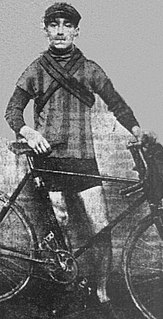Adolphe Heliere

|
|
| Adolphe Heliere | |
| To person | |
|---|---|
| Date of birth | March 10, 1891 |
| date of death | July 14, 1910 |
| nation |
|
| discipline | Street |
| Last updated: May 7, 2019 | |
Adolphe Hélière (born March 10, 1891 in Fécamp , † July 14, 1910 in Nice ) was a French cyclist. He drowned in 1910 on a rest day of the Tour de France in the Mediterranean.
Athletic career
Adolphe Hélière was the son of a railroad worker; at the age of 14 he started cycling. He lived with his parents in Rennes and worked as a car mechanic in order to be able to finance his starts in regional cycling races. A newspaper said at the time that he was a “bicycle fanatic”. The best result he knew was 13th place in the Paris-Le Mans race in 1910. In the same year, he fulfilled his dream of competing in the Tour de France , for which he spent all of his savings. His goal was to recommend himself to a professional team through good performance.
Hélière took part in the tour as an “independent” ( isolé ), which meant that he had to organize and finance his equipment, provisions and accommodation himself. It is said that the readers of the tour organizing cycling magazine L'Auto bet he would give up after three stages. When the co-favorite driver Émile Georget fell on the second stage, Hélière carried him on his shoulders to a house, where they were driven away by the owner with a baton. Georget won the stage the next day. Hélière himself fell on the sixth stage after colliding with a horse.
The sixth stage of the tour over 345 kilometers ended in Nice, where Hélière arrived over nine and a half hours after the stage winner, who had taken eleven hours and 46 minutes; so he had been on the road for over 21 hours. He finished 63rd out of 70 drivers still in the race. Since it was already the middle of the night and he had little money left, he lay down - like other drivers - on the beach to sleep. On the afternoon of the next day, a rest day, he returned to the beach with other racing drivers after lunch; It was very hot. Hélière went to bathe in the sea and went under immediately, presumably he had heat damage and was dehydrated . Another assumption was that he had come into contact with a fire jellyfish . His companions later testified that his nose was bleeding. Despite immediate rescue measures, only the death of the 19-year-old could be determined.
Because of the great heat, Hélière was immediately buried in Nice. L'Auto paid the family 100 francs to move his remains to Brittany . However, a total of 1000 francs was necessary, which was raised after ten months through donations. For example, a race was held at the Rennes Velodrome, the proceeds of which went to the Hélière family. A race in his honor was held there every year until the Second World War .
Adolphe Hélière was the first cyclist to be killed in a Tour de France accident, albeit not in the race itself.
Web links
- Adolphe Hélière in the Radsportseiten.net database
Individual evidence
- ↑ a b c Adolphe Hélière, premier coureur mort sur le Tour. In: ouest-france.fr. October 17, 2017, accessed May 7, 2019 .
- ↑ a b c d David Guénel: Adolphe Hélière, un cycliste au temps des isolés. In: velo-club.net. Retrieved May 7, 2019 (French).
- ^ 9 Tragic Tour de France Deaths. In: totalprosports.com. July 16, 2012, accessed May 7, 2019 .
- ↑ Yves-Marie Evanno: Adolphe Hélière, le cycliste inconnu mort pour le Tour de France. In: bcd.bzh. February 5, 2019, accessed May 7, 2019 (French).
| personal data | |
|---|---|
| SURNAME | Hélière, Adolphe |
| BRIEF DESCRIPTION | French cyclist |
| DATE OF BIRTH | March 10, 1891 |
| PLACE OF BIRTH | Fécamp |
| DATE OF DEATH | July 14, 1910 |
| Place of death | Nice |